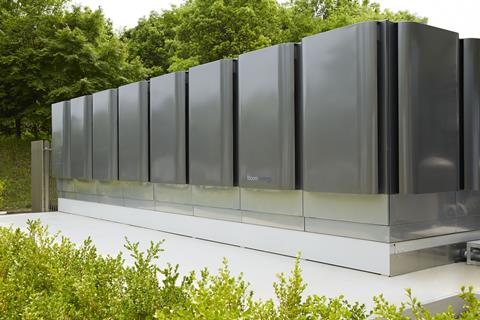Bloom Energy Corporation, Chantiers de l’Atlantique (CdA), and the cruise division of MSC Group will commission a solid oxide fuel cell (SOFC) auxiliary power system on the MSC World Europa later this year, paving the way for Bloom’s expansion into the maritime sector.
The new LNG-fuelled vessel, currently under construction at the CdA shipyard, has been fitted with 150 kilowatts of Bloom fuel cells which will run in parallel to the main auxiliary power systems onboard. The company’s proprietary solid oxide Energy Server technology uses natural gas, biogas, hydrogen or a mix of these feedstocks. In the case of the World Europa, the plug-and-play system will be installed in a 40-foot container and will be fuelled by LNG.
The fuel-flexible platform is designed to generate electricity 20-30% more efficiently than traditional marine combustion-based propulsion and auxiliary engines. When running on LNG, Bloom Energy’s technology reduces carbon equivalent emissions up to 60% compared to incumbent propulsion sources, such as dual fuel diesel electric, and emits virtually zero SOx, NOx, or particulate matter. Noise pollution and mechanical vibrations are also substantially reduced.
With more than 100 cruise ships requiring over 4GW due to be ordered by 2027, Bloom says its Energy Server technology is a viable pathway to decarbonisation. The company has seen a lot of enthusiasm from the cruise sector, but expects SOFC technology’s transition from auxiliary power system to main power system to be gradual to allow for confidence in the new technology to develop. Larger fuel cell installations are anticipated on additional ships in collaboration with the marine industry.
SOFC powered LNGC project
Bloom Energy has also partnered with Samsung Heavy Industries (SHI) on the design of an LNG carrier powered solely by fuel cells. This design has received Approval in Principle from DNV says Suminder Singh, senior director, engineering, marine applications. The market for Bloom Energy Servers on SHI ships could grow to 300MW annually. An SHI representative confirmed to The Motorship that the design was now expected to be made ready for order after 2025.
The name Energy Server originates from Bloom’s already strong position in the data centre market, and Singh says the modularity and redundancy required for that application makes the system well suited to shipping. “Our systems are supporting some large-scale, critical applications in data centres, hospitals and utility scale power generation systems, at megawatt scale,” says Singh.
Multiple solid oxide fuel cells combine to form fuel cell stacks, which are placed into independent modules. “We start with 75kW modules, and they can be combined into multi-MW applications. There’s no single point of failure which means even if one module goes down, there’s enough redundancy to ensure continued operations. Even our inverters and rectifiers operate in redundant mode, so there’s no electronic failure that could bring down the whole system.”
The electrolyte in SOFCs is a solid, ceramic material. The anode and cathode electrodes in Bloom’s fuel cells are proprietary inks that coat the electrolyte. Unlike other types of fuel cells, no precious metals, corrosive acids, or molten materials are required.
Operating at high temperatures inside the Energy Server, ambient air enters the cathode side of the fuel cell. Meanwhile, steam mixes with the LNG entering from the anode side to produce reformed fuel, which is hydrogen rich. As the reformed fuel crosses the anode, it attracts oxygen ions from the cathode. The oxygen ions combine with the reformed fuel to produce electricity, steam, and carbon dioxide. The steam that is produced in the reaction is recycled to reform the fuel, so no water is required during normal operation.
The system has been verified as an alternative power source for vessels as part of ABS’s New Technology Qualification process. It has also passed Factory Acceptance Test with Bureau Veritas and the customer to validate the safety of the entire system’s functionality and performance.
As global infrastructure for hydrogen and other emission-free fuels continue to develop, Singh says Bloom’s modular, fuel-flexible, and upgradeable platform can help to avoid the issue of stranded assets, granting the sector long-term flexibility and scalability for improved, future-proof, ship design.
The technology is ready for future fuel choices such as ammonia and methanol, although Singh says the reformation step for these fuels may initially be done externally to the system. Currently the reformation of LNG to produce hydrogen is done internally in the system’s “hot box” – this contrasts with PEM fuel cells where the reformation is handled externally.
Singh believes that fuel cells will change the future of ship design. No longer needing a centralised engine room, the modularity, customisation, and low-profile footprint of Bloom Energy’s system offers more flexibility in design, leading to a more efficient hull design and expanded cargo space.






